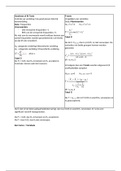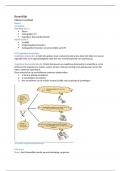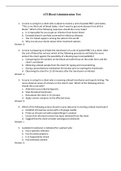Psychopathology
Definitions of abnormality:
Statistical Statistical infrequency:
infrequency - Occurs when an individual has a less common characteristics – something
that is not observed in the majority of the population.
- Any unusual behaviour is considered abnormal.
- Example:
o Intellectual disability disorder – with the average IQ range set at 85-
115, anyone with an IQ below 70 are characterised as abnormal and
are more likely to receive a diagnosis of intellectual disability
disorder.
- Strength:
o Real-life application – has application in the diagnosis of intellectual
disability disorder = place of statistical infrequency for thinking
about abnormal and normal behaviours. In clinical assessments,
there is a measurement of how severe their symptoms are to
statistical norms.
- Weaknesses:
o Unusual characteristics can be positive – IQ scores above 130 are
just as unusual but is not considered undesirable and needing
treatment. This is a limitation of statistical infrequency as it cannot
be used to make a diagnosis alone.
o Not everyone unusual benefits from a label – statistical infrequency
labels people as abnormal and with a diagnosis – but labelling may
have a negative effect on the way other view than and how they
view themselves – will result in distress where there is no need.
Deviation from Deviation from social norms:
social norms - Behaviour that is different from the accepted standards of behaviour in the
community or society.
- Making decisions about normality and abnormality based on whether
behaviour meets the collective judgement of societies standards.
- Norms are specific to the culture we live in, so they are different for each
generation and every culture.
- There are very few behaviours considered universally abnormal for
breaching social norms.
- Example:
o Antisocial personality disorder (psychopathy) – a person with
psychopathy is impulsive, aggressive and irresponsible. They fail to
conform to lawful or culturally normative behaviours. Failing to
meet social norms around moral standards. This is considered
abnormal in a wide range of cultures.
- Strength:
o Real-life application – can be used to diagnose APD – place for
thinking about what is normal and abnormal.
- Weaknesses:
o Not a sole explanation – need to consider other factors, such as
distress of others resulting from APD (failure to function
adequately). Cannot be the sole reason for defining abnormality.
o Cultural relativism – social norms vary from one culture to another
, and one generation to another – labelling someone abnormal in one
culture will not apply to another. E.g. hearing voices is socially
acceptable in some cultures but is abnormal in the UK. This is
problematic for those of one culture living within another.
o Human rights abuse – reliance on deviation from social norms for
defining abnormality can lead to systematic abuse of human rights
and provides a way to maintain control over minority groups and
women. May be abusing people’s right to be different.
Failure to function Failure to function adequately:
adequately - Occurs when someone is unable to cope with the demands of day-to-day
living – this may be an inability to maintain basic standards of nutrition and
hygiene, or unable to hold down a job and maintain relationships.
- Rosenhan and Seligman (1989) proposed signs that people are not coping:
o No longer conforming to standard interpersonal rules, e.g.
maintaining eye contact and respecting personal space.
o Experience of severe stress.
o Irrational or dangerous behaviour to themselves or others.
- Example:
o Intellectual disability disorder – criteria for having a very low IQ is a
statistical infrequency but a diagnosis should only be given if the
individual is also failing to function adequately.
- Strength:
o Patient’s perspective – does not attempt to include the subjective
experience of the individual but captures the experience of many
people who need help and is useful for assessing abnormality.
- Weaknesses:
o Simply deviation from social norms – it is hard to say if someone is
failing to function adequately or whether they are deviating from
social norms. E.g. not having a job or permanent address is
considered failure to function but some people choose to live like
that. Or seen as maladaptive if you practice extreme sports. Risk
limiting personal freedom and discriminating minority groups.
o Subjective judgements - deciding whether someone is failing to
function adequately requires judging distress which is subjective and
hard to make that decision. Objectivity has been partially achieved
with the Global Assessment of Functioning Scale which uses
checklists, but someone still has to make these judgements.
Deviation from the Deviation from ideal mental health:
ideal mental - Occurs when someone does not meet the criteria for good mental health.
health - We have a picture of what ‘psychologically healthy’ looks like and we
identify who deviates from this ideal.
- Jahoda (1958) good mental health meets this criteria:
o No symptoms of distress.
o Rational and can perceive ourselves accurately.
o Can self-actualise.
o Can cope with stress.
o Realistic view of the world.
o Good self-esteem and lack of guilt.
o Independent of other people.
o Can successfully work, love an enjoy our leisure.
- Some overlap in deviation form ideal mental heath and failure to function.
, - Strength:
o Comprehensive definition – covers a broad range of criteria for
mental health and all the reasons someone would seek help from
MH services or be referred for help – making it a good tool for
thinking about normality and abnormality of mental health.
- Weaknesses:
o Cultural relativism – classification of ideal mental health are specific
to Western European and American cultures (culture-bound). In
collectivist cultures, personal achievement for self-actualisation is
considered self-indulgent because they are not considering the
community. Traits for individualistic cultures are seen as abnormal
in collectivist cultures.
o Unrealistically high standards for mental health – unlikely to achieve
all of Jahoda’s criteria at the same time or keep them all for very
long, so would see us all as abnormal and mentally unhealthy = may
not have a value in thinking about who needs treatment.
o Labelling – causes more issues than not having a label and may put
someone in a bad position for employment and relationships.
EXAM QUESTIONS 3 marks:
Explain what is meant by statistical infrequency as a way to define abnormality.
Explain with an example what is meant by statistical infrequency.
Outline on criticism of statistical infrequency.
4 marks:
Explain what is meant by deviation from social norms as a way to define
abnormality.
Distinguish between statistical infrequency and deviation from social norms as ways
of defining abnormality.
(AO2 question) Frank has just been to a funeral and his family are concerned that he
is cracking jokes. Using the idea of deviation from social norms, explain why Frank’s
behaviour might be considered abnormal.
Explain what is meant by failure to function adequately.
Outline one strength of failure to function adequately definition of abnormality.
Explain what is meant by deviation from ideal mental health.
(AO2 question) Mike has low self-esteem and feels he has never fulfilled his
potential at work. He seeks help from a therapist who suggests that he does not
have ideal mental health. Explain what is meant by ideal mental health. Explain why
Mike can be seen as abnormal because he does not have ideal mental health.
Evaluate failure to function adequately as a way to define abnormality.
Distinguish between failure to function adequately and deviation from social norms
as definitions of abnormality.
16 marks:
Describe and evaluate two ways of defining abnormality.
Statistical infrequency and deviation from social norms are two ways of defining
abnormality. Describe and evaluate these two definitions of abnormality.
Failure to function adequately and deviation from ideal mental health are two ways
of defining abnormality. Describe and evaluate these two definitions of abnormality.
Definitions of abnormality:
Statistical Statistical infrequency:
infrequency - Occurs when an individual has a less common characteristics – something
that is not observed in the majority of the population.
- Any unusual behaviour is considered abnormal.
- Example:
o Intellectual disability disorder – with the average IQ range set at 85-
115, anyone with an IQ below 70 are characterised as abnormal and
are more likely to receive a diagnosis of intellectual disability
disorder.
- Strength:
o Real-life application – has application in the diagnosis of intellectual
disability disorder = place of statistical infrequency for thinking
about abnormal and normal behaviours. In clinical assessments,
there is a measurement of how severe their symptoms are to
statistical norms.
- Weaknesses:
o Unusual characteristics can be positive – IQ scores above 130 are
just as unusual but is not considered undesirable and needing
treatment. This is a limitation of statistical infrequency as it cannot
be used to make a diagnosis alone.
o Not everyone unusual benefits from a label – statistical infrequency
labels people as abnormal and with a diagnosis – but labelling may
have a negative effect on the way other view than and how they
view themselves – will result in distress where there is no need.
Deviation from Deviation from social norms:
social norms - Behaviour that is different from the accepted standards of behaviour in the
community or society.
- Making decisions about normality and abnormality based on whether
behaviour meets the collective judgement of societies standards.
- Norms are specific to the culture we live in, so they are different for each
generation and every culture.
- There are very few behaviours considered universally abnormal for
breaching social norms.
- Example:
o Antisocial personality disorder (psychopathy) – a person with
psychopathy is impulsive, aggressive and irresponsible. They fail to
conform to lawful or culturally normative behaviours. Failing to
meet social norms around moral standards. This is considered
abnormal in a wide range of cultures.
- Strength:
o Real-life application – can be used to diagnose APD – place for
thinking about what is normal and abnormal.
- Weaknesses:
o Not a sole explanation – need to consider other factors, such as
distress of others resulting from APD (failure to function
adequately). Cannot be the sole reason for defining abnormality.
o Cultural relativism – social norms vary from one culture to another
, and one generation to another – labelling someone abnormal in one
culture will not apply to another. E.g. hearing voices is socially
acceptable in some cultures but is abnormal in the UK. This is
problematic for those of one culture living within another.
o Human rights abuse – reliance on deviation from social norms for
defining abnormality can lead to systematic abuse of human rights
and provides a way to maintain control over minority groups and
women. May be abusing people’s right to be different.
Failure to function Failure to function adequately:
adequately - Occurs when someone is unable to cope with the demands of day-to-day
living – this may be an inability to maintain basic standards of nutrition and
hygiene, or unable to hold down a job and maintain relationships.
- Rosenhan and Seligman (1989) proposed signs that people are not coping:
o No longer conforming to standard interpersonal rules, e.g.
maintaining eye contact and respecting personal space.
o Experience of severe stress.
o Irrational or dangerous behaviour to themselves or others.
- Example:
o Intellectual disability disorder – criteria for having a very low IQ is a
statistical infrequency but a diagnosis should only be given if the
individual is also failing to function adequately.
- Strength:
o Patient’s perspective – does not attempt to include the subjective
experience of the individual but captures the experience of many
people who need help and is useful for assessing abnormality.
- Weaknesses:
o Simply deviation from social norms – it is hard to say if someone is
failing to function adequately or whether they are deviating from
social norms. E.g. not having a job or permanent address is
considered failure to function but some people choose to live like
that. Or seen as maladaptive if you practice extreme sports. Risk
limiting personal freedom and discriminating minority groups.
o Subjective judgements - deciding whether someone is failing to
function adequately requires judging distress which is subjective and
hard to make that decision. Objectivity has been partially achieved
with the Global Assessment of Functioning Scale which uses
checklists, but someone still has to make these judgements.
Deviation from the Deviation from ideal mental health:
ideal mental - Occurs when someone does not meet the criteria for good mental health.
health - We have a picture of what ‘psychologically healthy’ looks like and we
identify who deviates from this ideal.
- Jahoda (1958) good mental health meets this criteria:
o No symptoms of distress.
o Rational and can perceive ourselves accurately.
o Can self-actualise.
o Can cope with stress.
o Realistic view of the world.
o Good self-esteem and lack of guilt.
o Independent of other people.
o Can successfully work, love an enjoy our leisure.
- Some overlap in deviation form ideal mental heath and failure to function.
, - Strength:
o Comprehensive definition – covers a broad range of criteria for
mental health and all the reasons someone would seek help from
MH services or be referred for help – making it a good tool for
thinking about normality and abnormality of mental health.
- Weaknesses:
o Cultural relativism – classification of ideal mental health are specific
to Western European and American cultures (culture-bound). In
collectivist cultures, personal achievement for self-actualisation is
considered self-indulgent because they are not considering the
community. Traits for individualistic cultures are seen as abnormal
in collectivist cultures.
o Unrealistically high standards for mental health – unlikely to achieve
all of Jahoda’s criteria at the same time or keep them all for very
long, so would see us all as abnormal and mentally unhealthy = may
not have a value in thinking about who needs treatment.
o Labelling – causes more issues than not having a label and may put
someone in a bad position for employment and relationships.
EXAM QUESTIONS 3 marks:
Explain what is meant by statistical infrequency as a way to define abnormality.
Explain with an example what is meant by statistical infrequency.
Outline on criticism of statistical infrequency.
4 marks:
Explain what is meant by deviation from social norms as a way to define
abnormality.
Distinguish between statistical infrequency and deviation from social norms as ways
of defining abnormality.
(AO2 question) Frank has just been to a funeral and his family are concerned that he
is cracking jokes. Using the idea of deviation from social norms, explain why Frank’s
behaviour might be considered abnormal.
Explain what is meant by failure to function adequately.
Outline one strength of failure to function adequately definition of abnormality.
Explain what is meant by deviation from ideal mental health.
(AO2 question) Mike has low self-esteem and feels he has never fulfilled his
potential at work. He seeks help from a therapist who suggests that he does not
have ideal mental health. Explain what is meant by ideal mental health. Explain why
Mike can be seen as abnormal because he does not have ideal mental health.
Evaluate failure to function adequately as a way to define abnormality.
Distinguish between failure to function adequately and deviation from social norms
as definitions of abnormality.
16 marks:
Describe and evaluate two ways of defining abnormality.
Statistical infrequency and deviation from social norms are two ways of defining
abnormality. Describe and evaluate these two definitions of abnormality.
Failure to function adequately and deviation from ideal mental health are two ways
of defining abnormality. Describe and evaluate these two definitions of abnormality.












